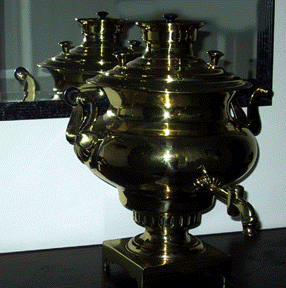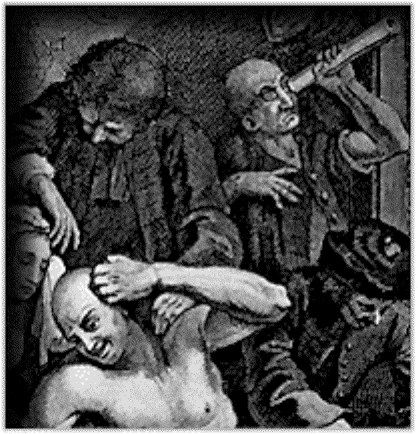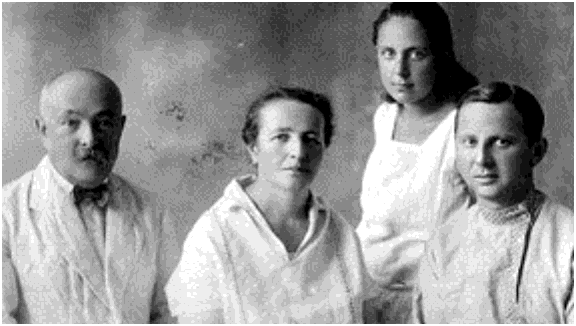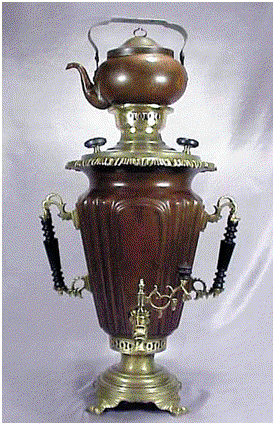and
Bedlam
<Michael Ingall

Some years ago a man, about thirty-four years of age, of almost Herculean size and figure, was brought to the house.
He had been afflicted several times before; and so constantly, during the present attack, had he been kept chained, that his clothes were contrived to be taken off and put on by means of strings without removing his manacles.
They were however taken off, when he entered the Retreat, and he was ushered into the apartment, where the superintendents were supping.
He was calm; his attention appeared to be arrested by his new situation. He was desired to join in the repast, during which he behaved with tolerable propriety.
After it was concluded, the superintendent conducted him to his apartment, and told him the circumstances on which his treatment would depend; that it was his anxious wish to make every inhabitant in the house as comfortable as possible; and that he sincerely hoped the patient's conduct would render it unnecessary for him to have recourse to coercion.
The maniac was sensible of the kindness of his treatment. He promised to restrain himself, and he so completely succeeded, that during his stay, no coercive means were ever employed towards him.
This case affords a striking example of the efficacy of mild treatment. The patient was frequently very vociferous, and threatened his attendants, who in their defence were very desirous of restraining him by the jacket.
The superintendent on these occasions, went to his apartment; and though the first sight of him seemed rather to increase the patient's irritation, yet after sitting some time quietly beside him, the violent excitement subsided, and he would listen with attention to the persuasions and arguments of his friendly visitor.
After such conversations, the patient was generally better for some days or a week; and in about four months he was discharged perfectly recovered.
Can it be doubted, that, in this case, the disease had been greatly exacerbated by the mode of management? or that the subsequent kind of treatment had a great tendency to promote his recovery.

Each morning the day would begin with "ward meeting," in which all twenty patients and all staff would sit in a circle in the common room. The meeting was led by Dr. James Skinner, a polished soft-spoken man, whose soothing voice and gentle manner had a calming influence on everyone. The meeting consisted of introductions of new patients, followed by occasional announcements, punctuated by interminable and awkward silences, rather like a Quaker meeting. If anyone said anything negative about another person, Dr. Skinner, like Thumper's mother, would somehow transform the insult into a warm and supportive comment.
Dr. Skinner came by his position honestly --- he had been analyzed by Helena Deutsch, who had been analyzed by Freud himself, so he was only two steps from the Master. That he was interested in dowsing for water and the transmittal of dreams through ESP did not detract from the honor in which he was held by all of psychoanalytic Boston.
Toward the end of the year, something happened. A group of patients coalesced into a band of foul-mouthed aggressive louts who attacked staff and each other verbally and physically. After Dr. Skinner's announcements at one morning meeting, the usual silence was broken by a voice from the circle, "Fuck you, Dr. Skinner!" The epithet quickly became a slogan echoed by a number of our charges, necessitating the early termination of the meeting and the retreat of the staff into the conference room.
"We need more limits, more restrictions," some suggested.
"We need to increase the dosage of medication," others advised.
"Let's discharge them all and start again from fresh," suggested one tough nurse.
Dr. Skinner sat at the head of the table, his pointed chin resting in his curled palm. "You know," he began, "What we really need is a bit of civility in the unit. I've been giving it some thought for a good while. I think it would be lovely if we served high tea for patients and staff at 4 PM. I've spoken with the hospital administration about getting a silver tea service, but they thought it was too much money. But we can't serve high tea in paper cups! Any ideas?"
My first thought was that he had been doing too much dowsing. But suddenly I blurted, "When I was growing up in Roxbury, my family had a silver samovar on the dining room bureau. We never used it, but it was for making tea. My father brought it with him when he left Russia during the Revolution. It's in the basement of my mother's house, I think, in a plastic bag. It's really very stylish. I could bring it in, and we could use it to make tea."

